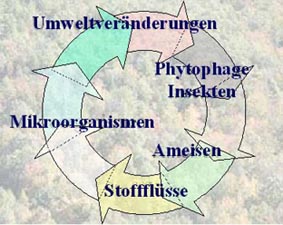|
Department of Animal Ecology
PD Dr. Bernhard Stadler |
 |

|

|
 |
 |  |
 |
 |
 |
 |
 |
 |
 |
 |
 |
 |
 |
 |
 |
Research>> internal Site (SSL) |
Linking phytophagous insects with ecosystem processes Studies on the biogeochemistry of ecosystems usually do not consider herbivores as an important component. This is partly due to the difficulty to experimentally manipulate their distribution or abundance and evaluate their role for the behaviour of ecosystems or maintenance of ecosystem services. Some species, however, hold key positions because their activities and abundance affects the distribution of many other species. For example, aphids feed on the phloem sap of their host plant and produce a sugary excreta (honeydew), which is used as energy resource by more than 250 insect species and micro-organisms.
They can also have economic importance because many aphids significantly reduce the growth performance of their host trees. Butterfly larvae feeding on leaves often produce large quantities of faeces, rich in carbon and nitrogen. We investigate infestation patterns on spruce and beech/oak forests and the effects on local ecosystem processes, e.g., on the carbon and nitrogen cycles from the phyllosphere down to the soil. The connection of the ecology of key functional organisms with ecosystem processes is an important step to further our understanding of the temporal variability and spatial heterogeneity in the flows of elements and nutrients in forested ecosystems. Exotic pest species Biodiversity and ecosystem functioning The local species composition and dynamics of communities are most likely very important for a number of ecosystem functions and services. However, the consequences of an altered biological diversity for the behaviour of ecosystems is difficult to evaluate because informative long term experiments are very difficult to perform. Different species have different importance at different periods of time for the structure of communities and for ecosystem functions. To identify these key organisms/key communities and the associated dynamics under changing environmental conditions is likely to increase in importance in the future, especially in the growing field of ecosystem management. Evolution of myrmecophile-ant interactions Antagonistic and mutualistic interactions between different organisms determine the structure of communities. Aphids and ants developed an array of interactions from non-attendance to obligate myrmecophily. The selection pressure that shaped this continuum of associations are largely unknown. Ants often consume honeydew of aphids, coccids and some lycaenid larvae and provide service functions, such as protection from natural enemies, in return.
Life history strategies of clonal insects Adaptation to environmental changes is a necessary prerequisite if organisms are to remain successful on an evolutionary time scale. The optimisation approach to life history strategies is a central theme in the fields of theoretical ecology and evolutionary biology. In combining experiments on the reproductive physiology and behaviour with models we seek to understand the phenotypic plasticity and trade-offs in key life-history characters on the fitness consequences for the respective organisms. Clonal organisms are especially useful to investigate such problems, because cause and effects can be followed across a number of genetically identical generations.
Aphids are characterised by a "telescoping" of generations, a mechanism by which parthenogenetic females not only produce daughters but also granddaughters at the same time in their bodies. Therefore, environmental effects might not only be seen in the current generation but feed forward to future generations more quickly than in bisexually reproducing organisms. This mode of reproduction is very effective to adapt to changing environmental conditions. |



